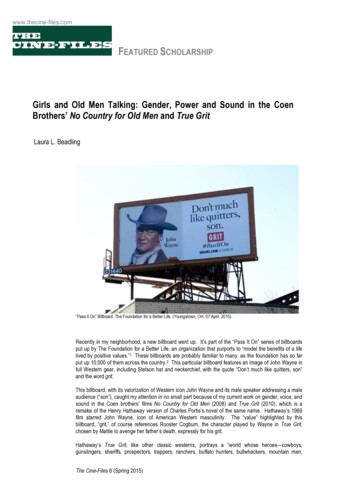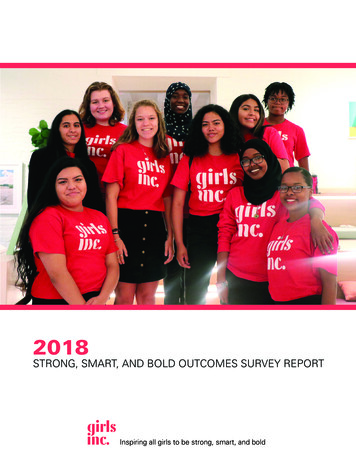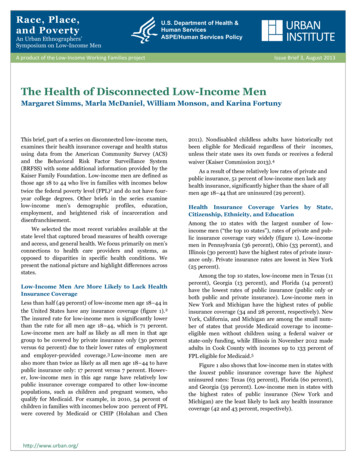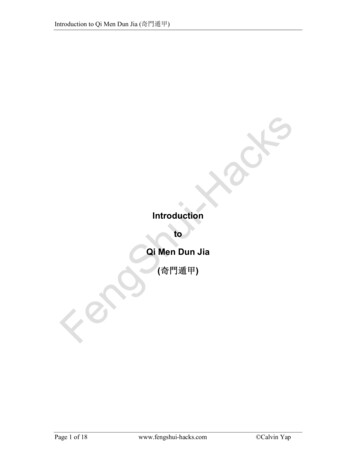
Transcription
www.thecine-files.comFEATURED SCHOLARSHIPGirls and Old Men Talking: Gender, Power and Sound in the CoenBrothers’ No Country for Old Men and True GritLaura L. Beadling“Pass it On” Billboard, The Foundation for a Better Life, (Youngstown, OH, 07 April, 2015).Recently in my neighborhood, a new billboard went up. It’s part of the “Pass It On” series of billboardsput up by The Foundation for a Better Life, an organization that purports to “model the benefits of a lifelived by positive values.”1 These billboards are probably familiar to many, as the foundation has so farput up 10,000 of them across the country.2 This particular billboard features an image of John Wayne infull Western gear, including Stetson hat and neckerchief, with the quote “Don’t much like quitters, son”and the word grit.This billboard, with its valorization of Western icon John Wayne and its male speaker addressing a maleaudience (“son”), caught my attention in no small part because of my current work on gender, voice, andsound in the Coen brothers’ films No Country for Old Men (2008) and True Grit (2010), which is aremake of the Henry Hathaway version of Charles Portis’s novel of the same name. Hathaway’s 1969film starred John Wayne, icon of American Western masculinity. The “value” highlighted by thisbillboard, “grit,” of course references Rooster Cogburn, the character played by Wayne in True Grit,chosen by Mattie to avenge her father’s death, expressly for his grit.Hathaway’s True Grit, like other classic westerns, portrays a “world whose heroes—cowboys,gunslingers, sheriffs, prospectors, trappers, ranchers, buffalo hunters, bullwhackers, mountain men,The Cine-Files 8 (Spring 2015)
2rodeo riders, and homesteaders—are white American Protestant males.”3 The liberties it took inadapting Portis’s novel significantly shifted the focus from Mattie onto Rooster/Wayne, cementing thefilm’s association with the “ideal, patriotic, conservative manhood” embodied by John Wayne.4 Wayne’sbrand of masculinity supports Andrew Spicer’s claim that “successful, competitive individualism” remainsthe “core American masculine myth,” a myth that continues to echo across the U.S., as the 2015billboard attests.5While there is no sustained analysis of genre covering the Coen oeuvre, many critics have noted that“genre subversion” is a Coen trademark, and several examine the genre complexities of specific Coenfilms.6 In particular, The Big Lebowski, because of its exuberant genre combining, has excited muchgeneric scholarship. For instance, J. M. Tyree and Ben Walters assert that “The Big Lebowski is not justthe story of a ransom gone wrong, it’s also a case study in genre gone wrong, genre gone wild, gonefishing, or gone bowling.”7 R. Barton Palmer characterizes The Big Lebowski as “postmodernpointlessness, with its wacky mixture of genres.”8 In contrast, Allen H. Redmon pointedly asserts thatthe film “amounts to more than the generic allusion or parody” and argues for a “constructivist use ofgenre” that allows viewers to participate in creating the narrative depending on which genre lens ischosen.9While The Big Lebowski has received the most robust genre analysis, many critics have more generallynoted references to the Western genre in many Coen films, including The Big Lebowski, RaisingArizona, and Blood Simple, as well as the more obvious heirs, No Country for Old Men and True Grit.The Coens deploy their trademark genre mixing throughout these films, with only True Grit being aWestern in the classical sense. Whereas critical commentary surrounding True Grit has recognized itunanimously as a Western, No Country has engendered less definitive generic classification, althoughmany, including William J. Devlin10 and Camilla Fojas, call it a neo-Western, most often because of itssetting in Texas and its inclusions of a Sheriff and a hardscrabble loner cowboy.11 Sonya Topolniskynotes that “the actors and the Coen brothers themselves have difficulty classifying No Country for OldMen, using the terms chase, horror, comedy, Western, and noir interchangeabl[ly]” while she herselfargues that No Country has “a strong family resemblance to the [Western] genre through itspreoccupation with violence and masculinity.”12While feminist critics have noted the rich and iconoclastic characterization of Marge Gunderson, thepregnant sheriff from Fargo (1996), a sustained consideration of gender roles in the Coen films remainsundeveloped. A focus on gender informs my essay, as I explore, in particular how No Country for OldMen and True Grit present characters that challenge the longstanding gender traditions of the Western.And more precisely, I will suggest that sound plays a key role in the films’ reconfigurations of gender inthe Western.Both No Country for Old Men and True Grit are neo-Westerns that undermine the typical genderhierarchy present in most classical Westerns through complex uses of voice-over narration and sound.Each film includes the Coens’ trademark violence and stylistic flair, but equally important to their uniquestyle is a particular use of voice-over narration and an investment in subverting not only genre butgender expectations. Kaja Silverman has commented on classic cinema’s tendency to hold “the femalevoice and body insistently to the interior of the diegesis, while relegating the male subject to a position ofapparent discursive exteriority by identifying him with mastering speech, vision, or hearing.”13 In their reimagining of the classic western genre, the Coens confront precisely this tradition of aggrandizing themale voice that Silverman identifies. Specifically in No Country, the male voice-over narrator movesfrom a disembodied position of power and authority to an embodied position of impotence, while in TrueGrit it is Mattie Ross’s voice that transcends the diegesis and provides the lens for understanding thestory and its meaning. Both No Country and True Grit recast issues of gender and sound to criticallyreflect upon the place and meaning of the Western.Sound, Music, and Voice in No Country for Old MenNo Country’s soundtrack is quite unusual in several ways. Most noticeably, there is very little music; outof its running time of 122 minutes, there are only 16 minutes of music, most of which come over theending credits. What music there is during the film itself is mostly droning and non-melodic, typicallyintroduced underneath the sound of a motor and thus almost imperceptible. Instead of music, thedominant presences on the sound track are voices, especially voice-over narration, and sound effects,including motors and other car sounds, gunshots, and, most importantly, the wind. The lack of musicThe Cine-Files 8 (Spring 2015)
3gives the sound effects and the voice room to shine, and they do, not only in enhancing realism, but alsoin furthering the narrative and deepening its thematic significance.While the soundtrack is often conceived of as enhancing the realism of a film narrative, in No Country,the sound and image tracks clash in several places. Silverman argues that “Insofar as the voice-overasserts its independence from the visual track, it presents itself as enunciator. It seems, in other words,to be a metafictional voice, the point of discursive origin,” and No Country at first seems to follow thisaesthetic.14 Bell’s voice-over narration begins on a black screen, before images fade in; as he speaks,the first few images depict extreme long shots of the landscape at daybreak, which then proceedsthrough the early morning hours. In one shot, the sun literally rises over a distant mountaintop. Bell’svoice is calm, authoritative, and absorbing as he reflects upon what it means to be a third-generationsheriff.link to film clip in criticalcommons.org: “Opening Sequence from NO COUNTRY FOR OLD MEN”This initial appearance of authority and power, however, is undercut in several ways as the filmcontinues. Mary Ann Doane argues that a voice heard in voice-over narration “is not localizable” and,because “it cannot be yoked to a body . . . it is capable of interpreting the image, producing its truth,”and this seems to be true of Bell’s opening narration, in which he claims authority over his county andproudly notes that he’s been sheriff there since he was twenty-five years old.15 While Bell’s voice-overnarration at first seems to embrace this power of enunciation, he soon admits his lack of knowledge andcertainty, particularly concerning a murderous young man Bell arrested and sent to death row. Afterdescribing the boy’s lack of remorse or passion, Bell baldly confesses “I don’t know what to make ofthat, I surely don’t,” and continues by saying that there’s crime and violence today that is so inexplicablethat it’s “hard to even take its measure.” During the ending of Bell’s monologue, when he is discussingthe murderous young man, the image track begins to zero in on a windmill. Bell’s monologue playsunder the first eleven shots of the film, most of which are extreme long shots of the empty landscape.Three shots towards the end of this sequence, however, are medium long shots and long shots of awindmill. As the voice-over dominates the sound track, the windmill comes to dominate the visual track;there is simply nothing else to listen to or look at.The Cine-Files 8 (Spring 2015)
4Windmill, shot 1. As the voice-over dominates the sound track, the windmill comes to dominate the visual track.Windmill, shot 2.Windmill, shot 3.The Cine-Files 8 (Spring 2015)
5This intrusion of the windmill into the sheriff’s voice-over offers an illuminating instance of counterpointbetween the image and the sound. The circular, endlessly spinning, man-made windmill evokes theendless cycle of human violence, calling into question Bell’s assertions that crime and violence areradically different today; its ceaselessly spinning wheel implies that crime and violence are constant andunchanging, as impossible to stop as the wind, which is heard on the soundtrack almost incessantlythroughout the film. Not only does the sound of the wind come before Bell’s voice-over narration, but itis the only sound that plays throughout his voice-over; most of the images in the voice-over montagealso show the wind moving grass and tree branches as well as the blades of the windmill. From the firstmoments of the film, the sound effect of the wind is, like the movement of the windmill blades,unchanging and unceasing, much as the film implies of human violence and evil.Later in the movie, Bell visits his disabled Uncle Ellis, also a law enforcement officer, now retired, andthis scene reinforces the above reading of the image track, which belies Bell’s voice-over. Although Bellgrandiosely glorifies “old timer” lawmen in his opening voice-over narration, Ellis, an actual olderlawman, is distinctly non-glorified. Living by himself with a crowd of half-feral cats, drinking rancidcoffee, confined to a wheelchair in a tiny isolated shack, Ellis defies Bell’s vision of old timers who nevereven had to carry a gun, such was their personal authority. Bell confesses to a love of hearing storiesabout the old timers and to measuring himself against their legends. Ellis does not play along with Bell’sromanticized visions, however, and he flatly tells Bell “what you got ain’t nothing new.” He relates astory of one of their relatives who was shot in his own doorway by pitiless men.As Ellis refuses Bell’s self-characterization as a lawman overmatched by the evil in the contemporaryworld, the camera depicts a shot of Bell looking out Ellis’s window, where he sees a windmill much likethe one showcased during Bell’s opening voice-over.Windmill, shot 4. Looking out Ellis’s window, Bell sees a windmill much like the one showcased during Bell’s opening voice-over.The Cine-Files 8 (Spring 2015)
6Windmill, shot 5.Windmill, shot 6.Throughout the scene, even when the windmill isn’t visible, sounds of the windmill creaking play on thesoundtrack. Pascal Bonitzer, concerned with the disembodied voice’s easy assumption of power andimposition of a singular point of view, argues that one way to “compromise the voice’s inherent authority”is to “make it relate to the image-track obliquely or ironically.”16 This is one of the ways in which theCoens undercut Bell’s power and authority: filmic motifs portray Bell as a disembodied voice of authorityin the early scenes, but soon enough show that his days of power are behind him through his ownwords, the ironic juxtaposition of his words with the image track, and, finally, as discussed below, byembodying him over the course of the film.Although Bell’s voice-over narration begins the film—his voice predates the image-track entirely—it isalmost a half an hour until he is seen on screen; as Tasha Robinson notes, the “sudden spate ofnarration comes from nowhere, and isn’t immediately pinned to anyone”.17 Silverman argues that themale subject finds “his most ideal realization when he is heard and not seen.”18 However, after settingthe tone and theme of the film, Bell’s presence takes a back seat and he is not seen until much later andhe is never again heard in voice-over. His power and authority have already begun to erode, and thisprocess will inexorably continue over the course of the film.Throughout the course of No Country, Bell moves from an authoritative position as disembodied voiceover narrator only to end the film in an embodied monologue in which he is shown dressed in civilianclothes, talking to his wife, who tartly tells him she can’t accompany him on a ride because she’s notThe Cine-Files 8 (Spring 2015)
7retired and then follows it up by telling him she doesn’t need or want his help around the house. Sheconvinces Bell to describe his dreams from the previous night, which he finally does. This monologueends the film.link to clip in criticalcommons.org: “Ending scene from NO COUNTRY FOR OLD MEN”For as long as the voice is heard and the body not seen, it has “the scope of an oracle” but the voice is“submitted to the destiny of the body” once the voice and body are reunited in synchronous sound.19Bell’s power and authority diminish over the course of the film as he goes from oracular disembodiedvoice to defeated old man, housebound and henpecked.The fact that Bell’s description of his dreams has an audience—his wife—is a choice that the Coenbrothers made; in the McCarthy novel, Bell’s final speech is italicized, marking an inner monologue, andhas no audience other than the reader. It would have been a simple matter for the Coens to preservethis structure in the film and have Bell end the film with another voice-over speech. The fact that theychoose not do this shows that their use of voice-over is strategic and thematically important. Thenarrative itself overtly shows that Sheriff Bell is incapable of continuing in his capacity as sheriff and,indeed, by the end, he has retired and is safely ensconced in the domestic realm. His voice follows thesame arc, from occupying what Pascal Bonitzer calls the “voice of knowledge par excellence in all films”as a disembodied, apparently third person narrator to a voice confined to a body, mortal, frail, afraid,while the outlaw simply walks away.20The lawman has not just failed or been killed by the villain; he has given up altogether and never evenconfronts the outlaw, an unprecedented choice for a Western. The Coens portray an iconic Westernsheriff who revels in the heroic tales of the American frontier but who retreats from the field rather thanconfront an adversary who frightens and confounds him. By emphasizing Bell’s reverence for the “oldtimers” via his own heroic opening voice-over while depicting his failure through the rest of the film, theCoens show the hollowness of Westerns that purport to instruct viewers on American masculinity whilereally only creating unrealistic stereotypes. In this view, No Country becomes a critique of Westerns thatcreated and continue to perpetuate the unattainable masculinity of John Wayne’s characters, such asthat shown on the “Pass It On” billboard.The Sound of Mattie in True GritIn contrast to No Country’s stark soundtrack that features little music in order to emphasize the voiceand the wind, the Coen bothers’ True Grit is filled throughout with several voice-over sections as well aswith evocative and rich music. As Carter Burwell, the film’s composer and long-time Coen collaborator,points out, “The music is non-stop from the time Mattie sees Chaney, her father's killer, until the end ofthe film” and, in fact, the music is an almost-constant presence.21 By far the most prominent voicebelongs to the girl protagonist, Mattie Ross, who hires Federal Marshall Rooster Cogburn to pursue herfather’s killer into Indian Country. While the 1969 film adaptation of True Grit, directed by HenryHathaway and starring John Wayne, put Cogburn at the center of the narrative, Burwell notes that theCoens put Mattie rather than Rooster at the center of the story, as Charles Portis’s novel of the samename does. In the Coens’ version, the music and Mattie’s voice work together to foreground Mattie’sworld view and point of view while Rooster and LaBouef are made into supporting characters.The choice of Mattie, a fourteen year old girl, as a protagonist for a Western film is very unusual; JohnBelton points out that women in Westerns are often “the forces of civilization, embodying the values ofThe Cine-Files 8 (Spring 2015)
8family, community, education, domestication, and cultivation that informs the male hero’s transformationof the wilderness into a garden.”22 Mattie straddles both worlds in that she calls upon the forces ofcivilization freely when needed, most notably Lawyer Dagget, while still being as bent on vengeance asany male hero whose kin was killed. Lee Clark Mitchell argues that Westerns as a genre “fret over theconstruction of masculinity” and, from the beginning, have been “deeply haunted by the problem ofbecoming a man.”23 Mattie, as a fourteen-year-old girl, is not only uninterested in masculinity, but she’snot particularly interested in being or becoming feminine either. She is, like many a Western protagonistbefore her, on a simple but bloody quest for justice in an environment where justice is often vigilante.Such typical Western themes, however, cannot help but look very different when carried out by a younggirl; the Coens’ focus on Mattie brings this thematic material to the fore.Mattie’s primary preoccupation is not masculinity or femininity but righteousness and a balancing ofaccounts. While Portis’s novel infuses Mattie’s narration with a vigorous religiosity through regularreferences to scripture, many asides in which Mattie comments upon religious matters of her time, andBiblical themes of grace and redemption, the Coens’ film reinforces that narration with music. AsBurwell notes in his commentary on the film on his website, Mattie “doesn't narrate the body of the film,however, and I came to think that a score based on church music would put her quest in context.”Burwell and the Coens decided on Protestant hymns from the film’s period, the late nineteenth century.Making Mattie a voice-over narrator is also an unusual choice for a Western. As Sarah Kozloff writes,“female narrators are likely to be confined to a certain domestic or personal ghetto,” generally narratingtheir own lives in “’women’s films,’ adaptations, and occasional noirs,” so having a woman narrate herown adventures and perspective on this most American and most masculine of genres makes it aninteresting case study for genre, gender, and voice.24While the hymn-based music chosen by Burwell and the Coens in some ways adheres to typical uses offilm music, it also accomplishes some more subtle narrative work as well. Film music theorist Roy M.Prendergast notes that one of the main purposes of film music is to create “color,” an “atmosphere oftime and place,” immediately in an audience who may be musically “unsophisticated.”25 Musical color,Prendergast continues, is associative and immediate, unlike building musical themes and motifs, whichtake time, and, perhaps most importantly, musical color “is not intrusive; it does not compete with thedramatic action.”26 This is the most apparent use of True Grit’s music, especially during the firstmoments of the film and during Mattie’s opening voice-over narration. The film opens with her relatingthe account of her father’s murder at the hands of Tom Chaney, while the score features a lone pianoplaying one of the most important pieces of music in the film, “Leaning on the Everlasting Arms.” Thehymn first provides thematic color by implying a time and atmosphere of stark religiosity instead of highspirited adventure and derring-do.Eventually, over the course of the narrative, “Leaning on the Everlasting Arms” becomes the theme forMattie and a dominant musical motif overall; Burwell estimates that the hymn features in about a quarterof the score in one form or another, and its dominance on the soundtrack reflects both Mattie’s status asmain character as well as her religious and harsh outlook. Burwell notes that he did not want to usemodern versions of the hymns, which he found “distinctly uninspiring.” He describes how thecontemporary arrangements were meant to sound “warm, comforting, uplifting,” which was not the tonehe was striving for. The West depicted in the Coens’ True Grit is not the realm for heroic cowboys andcavalrymen rescuing innocent settlers from marauding Natives, thus Burwell wanted to avoid as muchas possible the use of music to “sanctify myths about the origin of the United States.”27 So the sparepiano music playing alongside Mattie’s opening voice-over narration creates an appropriate color for thisparticular Western by emphasizing the stark, harsh realities of life in the 1870s, especially for womenand children on the frontier.In addition to creating an appropriate atmosphere in the first few minutes of the film, “Leaning on theEverlasting Arms” is an appropriate theme for her character because, as Burwell notes, “Mattie hasnever seen a Hollywood Western, nor read a Western novel. Her pieties derive from her knowledge ofthe Bible, and her courage is really a Presbyterian self-righteousness.”28 She is uncompromising andsure of herself, which is unusual for a girl in a Western film, a genre in which it is far more common forgirls and women to be off-screen motivators for male actions, like Debbie in The Searchers or theprostitute whose cut face serves as the inciting incident of Unforgiven. Mattie faces setbacks during herquest, including the humiliation of being spanked by LaBouef for daring to cross the river in defiance ofRooster’s desire to leave her behind. Despite these obstacles, the film does not revel in degrading heror showing her as incompetent, although it does not glorify her or show her as without fault either.The Cine-Files 8 (Spring 2015)
9To complement the hymns that dominate the musical score, Mattie’s various voice-over speechesinclude numerous religious references. The film begins with an epigraph from Proverbs (“The wickedflee when none pursueth”) while Mattie’s opening voice-over ends with her asserting that there is“nothing free in this world except the grace of God.” Likewise, in Mattie’s letter to her motherannouncing her intention to pursue Tom Chaney alongside Cogburn, which the audience hears in voiceover, she says “though I walk through the valley of the shadow of death, I shall fear no evil. The authorof all things watches over me.” Unlike many voice-over narrators who open a film and then are neverheard from again, Mattie’s voice, with its religious overtones, is heard throughout the film.Mattie’s viewpoint is never seriously challenged throughout the film, certainly not in the manner in whichSheriff Bell’s voice-over is undercut and then eliminated altogether. Silverman argues that the femalesubject, unlike the male, is not only denied the position of disembodied enunciator, but she is alsoconfined “within the story,” and to positions “which come within eventual range of male vision oraudition.”29 As the primary focalizing character, the insertion of Mattie’s voice structures the film: hervoice-over narration opens the film, her voice in the form of a letter read to her mother announces thatthe great adventure has begun and moves the narrative to Indian Country, and her voice-over reflectioncloses the film.Despite this, though, the audience hears two other characters in voice-over as well, both of whichchallenge or scold Mattie. But instead of including multiple voice-over narrators that disempower ordilute Mattie’s voice, the Coens use these secondary speakers to showcase her fortitude and certainty.The first is her much-called-upon lawyer, J. Nobel Dagget, who writes in response to Mattie’shorsetrading with Colonel Stonehill. Mattie strategically deploys Dagget’s name throughout her dealingswith Stonehill (and others), calling upon his authority to back hers. Despite this, it is clear that it is Mattieand her shrewd dealing that gets the best of Stonehill. When Dagget writes to her, he claims he isn’t“scolding” Mattie, but clearly he is, even as he realizes this is a useless gesture. He warns that her“headstrong ways” will get her into trouble one day, which they do, and he expresses his “wish” that shewould leave such business matters to him, even though he knows she will not. In the end, he backs herand provides the legal document that she needs to conclude her trading which finances the pursuit ofChaney. Although Dagget concludes his letter by indicating that he has enclosed the legal document sothat she may finish her business and return home, Mattie simply disregards this and continues as shesees fit. Dagget, though he is a disembodied voice-over narrator, is simply no match for Mattie, teenagegirl though she may be. Rather than a typical male voice-over narrator who speaks from off screen andthus cannot be questioned, Dagget is but a means to Mattie’s ends and his voice is simply ignored.In addition to Dagget, the other voice heard in voice-over is Cogburn’s, also in a letter that he narrates tothe audience; unlike Lawyer Dagget, Cogburn does not take Mattie’s personality or wishes into account.Cogburn, for his part, is as bald and blunt as Dagget is careful and indirect. Whereas Dagget opens andcloses his letter by addressing Mattie and then signing himself, “Yours, J. Nobel Dagget,” Cogburnsimply writes his orders bluntly: “Here inside is a train ticket for your return home. Use it.” He alsothinks he has presented her with a fait accompli by telling her to meet him at 7AM, by which time he hasalready crossed the river into Indian Country; “pursuit would be futile” he tells her, and he closes byordering her to leave him to his work.Despite the differences between Cogburn and Dagget, Mattie’s response is the same; she simply doesas she will. Pascal Bonitzer notes that one way to undercut the power and authority of a voice-overnarrator is to “multiply it”; he notes that including multiple voice-over narrators dilutes the power andauthority accorded any one of them.30 This is not true in True Grit, however, because Mattie does notpay the smallest bit of attention to the orders given to her in the letters presented in voice-over despitethe fact that both are narrated by older, authoritative male characters. Mattie quite simply ignoresCogburn’s orders, as she ignored Dagget’s implied instructions, and heads to the river, where shedemands the ferryman take her across to Cogburn, who is only now on the other side of the river.Cogburn anticipated this, though, and left orders for the ferryman to take Mattie, whom he has labelled a“runaway,” to the sheriff. Mattie, as always, is resourceful and stubborn. After distracting the man with athrown apple, she gallops her horse into the river and they swim across where she finds that Cogburnand LaBouef have joined forces.As Mattie goes on her “coon hunt,” as Cogburn calls it, the film’s music changes. From the hymns thatevoke Mattie’s sense of Presbyterian righteousness at the start the film, the music evolves thematicallyThe Cine-Files 8 (Spring 2015)
10into an orchestral score more typical for a Western at the moment when Mattie joins Cogburn andLaBouef across the river. This change includes the typical brass, strings, and timpani usuallyassociated with the Western score as Mattie plunges with her ill-fated pony, Blackie, across the river intoIndian Territory, defying all the “voices” in the first act of the film. It is at this point that the manhunt trulygets underway. The theme that accompanies Mattie’s surprise river crossing is a melody called “YourHeadstrong Ways,” titled, of course, after Lawyer Dagget’s prophetic admonishment in his letter (“Yourheadstrong ways will lead you into a tight corner one day”). As she follows Cogburn and LaBouef intoIndian Country, the music becomes less hymn-like in order to convey Mattie’s moving away from theknown and familiar to things beyond her experience. Additionally, the film’s music becomes moretraditionally “Western” by using a bigger sound with more brass and percussion, as in the river crossingas well as the shootout between Cogburn, LaBouef, and the Ned Pepper gang.At the film’s climax, the music once again changes and defies expectation. Moviegoers might expect abig, orchestral score to represent the urgency and high stakes of Cogburn’s race to save Mattie’s lifeafter she has been bitten by a rattlesnake. The music at this point in the 1969 Henry Hathaway versionof True Grit was all those things. In contrast, though, the Coens and Burwell decided to revise Mattie’stheme, “Leaning on the Everlasting Arms”; even when the narrative focuses on Cogburn’s heroics, thenarrative itself reflects Mattie’s perspective and her character’s development. The hymn, slow andspare as ever, performed upon a lone piano, plays as Cogburn carries Mattie to the
Men and True Grit present characters that challenge the longstanding gender traditions of the Western. And more precisely, I will suggest that sound plays a key role in the films' reconfigurations of gender in the Western. Both No Country for Old Men and True Grit are neo-Westerns that undermine the typical gender










